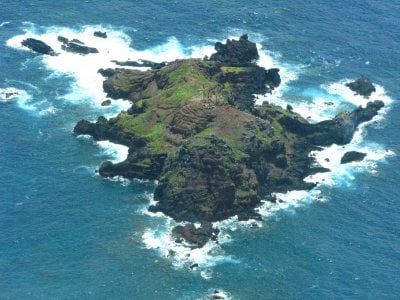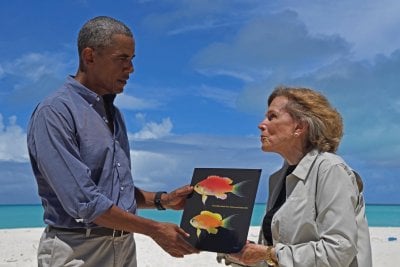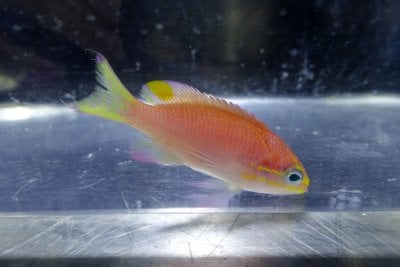Images used are either public domain images from morgue file or images taken from National Geographic and used under fair use purposes.
Christine Tod-Whitman, the former governor of New Jersey and former administrator of the EPA (Environmental Protection Agency) was quoted as saying, “President Obama will certainly be remembered for elevating the issue of climate change and bringing considerations about climate change to the forefront.”
The former governor of Utah, and EPA administrator during 2005 Mike Leavitt said, “[Obama’s policies] have combined to make the United States a leader in clean energy.”
Last week, the president greatly expanded the Papahānaumokuākea reserve in North-Western Hawaii. The area is home to Kure atoll and made national news years before when then President George W. Bush set-up a large marine reserve there, after a meeting with ocean explorer, conservationist and film-maker Jean Michele Cousteau. President Bush’s preserve was one of the first of its kind, a large swath of reefs, islands and open water fully protected by the federal government of the United States. President Obama has expanded on Bush’s framework, creating a marine preserve twice the size of Texas. Both President Bush’s actions years ago and Obama’s actions recently are milestones; high ranking elected officials of both major political parties recognizing the diversity, importance and fragility of marine ecosystems. Papahānaumokuākea reserve represents an area with the greatest number of endemic species in the world. This means that more fish only occur in Papahānaumokuākea than anywhere else in the world. Protecting an area with such a wide frame of endemic species will be paramount to preserving oceanic diversity in the future. Along with endemic fish species, sea-turtles and monk seals had a major win with Obama’s expansion of the marine preserve.
Papahānaumokuākea was first protected in 1909, when then president Theodore Roosevelt established the Hawaiian Islands Bird Reservation, via an executive order. Roosevelt's decision was in response to over-harvesting of sea-birds and his appreciation of National Wildlife Heritage initiatives. In 1940 President Franklin Roosevelt converted the bird reservation to the Hawaiian Islands National Wildlife Refuge, which increased protective measures for a greater diversity of animals living within the area.
Small, incremental expansions took place over the next few decades, culminating in the Midway Atoll Wildlife Refuge (founded in 1988) and the Kure Atoll Wildlife Regue (founded in 1993). In 2000 President Bill Clinton established the Northwestern Hawaiian Islands Coral Reef Ecosystem Reserve via an executive order.
In 2006, President George W. Bush signed Proclamation 8031 which designated the North Western Hawaiian islands a National Monument under the 1906 Antiquities Act which spared the measure a one-year evaluation and extended period of public comment and debate.
President Obama's 2016 expansion of the monument is historic, as it increases the size of Papahānaumokuākea by roughly four times, making it the largest protected marine preserve on the planet.
Yet, there was an award for the president’s action, one that seems almost like providence. Not long ago, celebrity marine biologist Dr. Richard Pyle (star of Coral Reef Adventure, a popular iMax film) spotted an unfamiliar fish while diving the Papahānaumokuākea reserve. He collected one of the colorful pink and yellow fish, which turned out to be a male of a previously undescribed species. There was a catch, that seemed like an intervention of fate. A red circle on the fish’s tale, ringed in blue. It appeared almost like the campaign logo used by President Obama during his record breaking campaign in 2007-2008. It was then that Pyle decided to honor America’s 44th president, forever enshrining his name and tenure in office within the scientific name of a marine fish species.
The process of declaring a new fish species isn’t as simple as the outlook of one, or even a team of marine biologists. It will take time, DNA tests and a close inspection of the fish’s physical details and physiology before a formal scientific name is applied. Considering the fish is of the genus Tosanoides (a species previously thought to only occur around Japan) it’s likely the final name will be Tosanoides obama or some variant of that.
Last Thursday on Midway Atoll, President Obama met with famed ocean explorer and conservationist Sylvia Earle to receive a picture of the fish named in his honor, and to discuss the future of oceanic conservation. During the short ceremony, it was hard to tell who was a bigger fan of who. Was Earle a bigger fan of Obama, or was Obama a bigger fan of Earle? The President stated that he has been following Earle’s work for decades. Just adding to the significance of the event is the fact that Hawaii is the President’s home-state.
Papahānaumokuākea’s 17 genera and 22 species only occur in Northwestern Hawaii, meaning that protection of this biological wonderland and endemic hotspot is crucial. Hopefully with both President Bush and President Obama’s work to create massive marine preserves, they will be protected for generations to come.
It’s not the first time President Obama has had a species of fish named after him. In 2012 scientists named a small fish endemic to Tennessee drainages and rivers after President Obama. The fish, Etheostoma Obama, is blue and orange, moving like a flash through turbulent waters. The scientists wanted to honor the president’s commitment to environmental stewardship and clean-energy. Other presidents have been honored with darter-fish species names in their liking. Former president Jimmy Carter, Bill Clinton, Theodore Roosevelt and former vice president Al Gore all have darter-fish named after them.
Christine Tod-Whitman, the former governor of New Jersey and former administrator of the EPA (Environmental Protection Agency) was quoted as saying, “President Obama will certainly be remembered for elevating the issue of climate change and bringing considerations about climate change to the forefront.”
The former governor of Utah, and EPA administrator during 2005 Mike Leavitt said, “[Obama’s policies] have combined to make the United States a leader in clean energy.”
Last week, the president greatly expanded the Papahānaumokuākea reserve in North-Western Hawaii. The area is home to Kure atoll and made national news years before when then President George W. Bush set-up a large marine reserve there, after a meeting with ocean explorer, conservationist and film-maker Jean Michele Cousteau. President Bush’s preserve was one of the first of its kind, a large swath of reefs, islands and open water fully protected by the federal government of the United States. President Obama has expanded on Bush’s framework, creating a marine preserve twice the size of Texas. Both President Bush’s actions years ago and Obama’s actions recently are milestones; high ranking elected officials of both major political parties recognizing the diversity, importance and fragility of marine ecosystems. Papahānaumokuākea reserve represents an area with the greatest number of endemic species in the world. This means that more fish only occur in Papahānaumokuākea than anywhere else in the world. Protecting an area with such a wide frame of endemic species will be paramount to preserving oceanic diversity in the future. Along with endemic fish species, sea-turtles and monk seals had a major win with Obama’s expansion of the marine preserve.
Papahānaumokuākea was first protected in 1909, when then president Theodore Roosevelt established the Hawaiian Islands Bird Reservation, via an executive order. Roosevelt's decision was in response to over-harvesting of sea-birds and his appreciation of National Wildlife Heritage initiatives. In 1940 President Franklin Roosevelt converted the bird reservation to the Hawaiian Islands National Wildlife Refuge, which increased protective measures for a greater diversity of animals living within the area.
Small, incremental expansions took place over the next few decades, culminating in the Midway Atoll Wildlife Refuge (founded in 1988) and the Kure Atoll Wildlife Regue (founded in 1993). In 2000 President Bill Clinton established the Northwestern Hawaiian Islands Coral Reef Ecosystem Reserve via an executive order.
In 2006, President George W. Bush signed Proclamation 8031 which designated the North Western Hawaiian islands a National Monument under the 1906 Antiquities Act which spared the measure a one-year evaluation and extended period of public comment and debate.
President Obama's 2016 expansion of the monument is historic, as it increases the size of Papahānaumokuākea by roughly four times, making it the largest protected marine preserve on the planet.
Yet, there was an award for the president’s action, one that seems almost like providence. Not long ago, celebrity marine biologist Dr. Richard Pyle (star of Coral Reef Adventure, a popular iMax film) spotted an unfamiliar fish while diving the Papahānaumokuākea reserve. He collected one of the colorful pink and yellow fish, which turned out to be a male of a previously undescribed species. There was a catch, that seemed like an intervention of fate. A red circle on the fish’s tale, ringed in blue. It appeared almost like the campaign logo used by President Obama during his record breaking campaign in 2007-2008. It was then that Pyle decided to honor America’s 44th president, forever enshrining his name and tenure in office within the scientific name of a marine fish species.
The process of declaring a new fish species isn’t as simple as the outlook of one, or even a team of marine biologists. It will take time, DNA tests and a close inspection of the fish’s physical details and physiology before a formal scientific name is applied. Considering the fish is of the genus Tosanoides (a species previously thought to only occur around Japan) it’s likely the final name will be Tosanoides obama or some variant of that.
Last Thursday on Midway Atoll, President Obama met with famed ocean explorer and conservationist Sylvia Earle to receive a picture of the fish named in his honor, and to discuss the future of oceanic conservation. During the short ceremony, it was hard to tell who was a bigger fan of who. Was Earle a bigger fan of Obama, or was Obama a bigger fan of Earle? The President stated that he has been following Earle’s work for decades. Just adding to the significance of the event is the fact that Hawaii is the President’s home-state.
Papahānaumokuākea’s 17 genera and 22 species only occur in Northwestern Hawaii, meaning that protection of this biological wonderland and endemic hotspot is crucial. Hopefully with both President Bush and President Obama’s work to create massive marine preserves, they will be protected for generations to come.
It’s not the first time President Obama has had a species of fish named after him. In 2012 scientists named a small fish endemic to Tennessee drainages and rivers after President Obama. The fish, Etheostoma Obama, is blue and orange, moving like a flash through turbulent waters. The scientists wanted to honor the president’s commitment to environmental stewardship and clean-energy. Other presidents have been honored with darter-fish species names in their liking. Former president Jimmy Carter, Bill Clinton, Theodore Roosevelt and former vice president Al Gore all have darter-fish named after them.

















